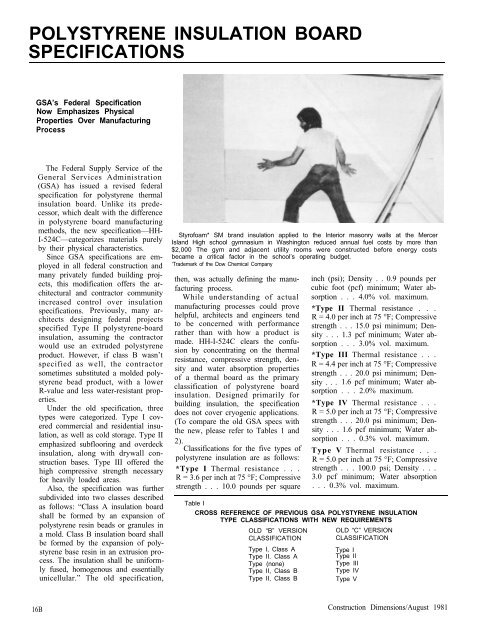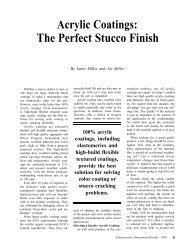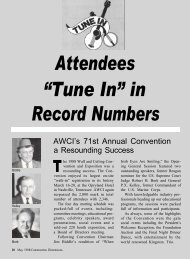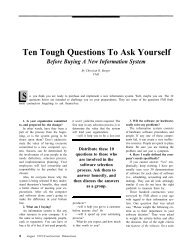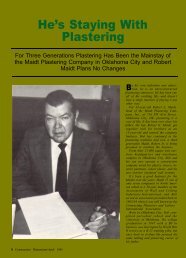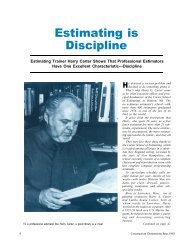Polystyrene Insulation Board Specifications - AWCI
Polystyrene Insulation Board Specifications - AWCI
Polystyrene Insulation Board Specifications - AWCI
You also want an ePaper? Increase the reach of your titles
YUMPU automatically turns print PDFs into web optimized ePapers that Google loves.
POLYSTYRENE INSULATION BOARD<br />
SPECIFICATIONS<br />
GSA’s Federal Specification<br />
Now Emphasizes Physical<br />
Properties Over Manufacturing<br />
Process<br />
The Federal Supply Service of the<br />
General Services Administration<br />
(GSA) has issued a revised federal<br />
specification for polystyrene thermal<br />
insulation board. Unlike its predecessor,<br />
which dealt with the difference<br />
in polystyrene board manufacturing<br />
methods, the new specification—HH-<br />
I-524C—categorizes materials purely<br />
by their physical characteristics.<br />
Since GSA specifications are employed<br />
in all federal construction and<br />
many privately funded building projects,<br />
this modification offers the architectural<br />
and contractor community<br />
increased control over insulation<br />
specifications. Previously, many architects<br />
designing federal projects<br />
specified Type II polystyrene-board<br />
insulation, assuming the contractor<br />
would use an extruded polystyrene<br />
product. However, if class B wasn’t<br />
specified as well, the contractor<br />
sometimes substituted a molded polystyrene<br />
bead product, with a lower<br />
R-value and less water-resistant properties.<br />
Under the old specification, three<br />
types were categorized. Type I covered<br />
commercial and residential insulation,<br />
as well as cold storage. Type II<br />
emphasized subflooring and overdeck<br />
insulation, along with drywall construction<br />
bases. Type III offered the<br />
high compressive strength necessary<br />
for heavily loaded areas.<br />
Also, the specification was further<br />
subdivided into two classes described<br />
as follows: “Class A insulation board<br />
shall be formed by an expansion of<br />
polystyrene resin beads or granules in<br />
a mold. Class B insulation board shall<br />
be formed by the expansion of polystyrene<br />
base resin in an extrusion process.<br />
The insulation shall be uniformly<br />
fused, homogenous and essentially<br />
unicellular.” The old specification,<br />
Styrofoam* SM brand insulation applied to the Interior masonry walls at the Mercer<br />
Island High school gymnasium in Washington reduced annual fuel costs by more than<br />
$2,000 The gym and adjacent utility rooms were constructed before energy costs<br />
became a critical factor in the school’s operating budget.<br />
‘Trademark of the Dow Chemical Company<br />
then, was actually defining the manufacturing<br />
process.<br />
While understanding of actual<br />
manufacturing processes could prove<br />
helpful, architects and engineers tend<br />
to be concerned with performance<br />
rather than with how a product is<br />
made. HH-I-524C clears the confusion<br />
by concentrating on the thermal<br />
resistance, compressive strength, density<br />
and water absorption properties<br />
of a thermal board as the primary<br />
classification of polystyrene board<br />
insulation. Designed primarily for<br />
building insulation, the specification<br />
does not cover cryogenic applications.<br />
(To compare the old GSA specs with<br />
the new, please refer to Tables 1 and<br />
2).<br />
Classifications for the five types of<br />
polystyrene insulation are as follows:<br />
*Type I Thermal resistance . . .<br />
R = 3.6 per inch at 75 °F; Compressive<br />
strength . . . 10.0 pounds per square<br />
inch (psi); Density . . 0.9 pounds per<br />
cubic foot (pcf) minimum; Water absorption<br />
. . . 4.0% vol. maximum.<br />
*Type II Thermal resistance . . .<br />
R = 4.0 per inch at 75 °F; Compressive<br />
strength . . . 15.0 psi minimum; Density<br />
. . . 1.3 pcf minimum; Water absorption<br />
. . . 3.0% vol. maximum.<br />
*Type III Thermal resistance . . .<br />
R = 4.4 per inch at 75 °F; Compressive<br />
strength . . . 20.0 psi minimum; Density<br />
. . . 1.6 pcf minimum; Water absorption<br />
. . . 2.0% maximum.<br />
*Type IV Thermal resistance . . .<br />
R = 5.0 per inch at 75 °F; Compressive<br />
strength . . . 20.0 psi minimum; Density<br />
. . . 1.6 pcf minimum; Water absorption<br />
. . . 0.3% vol. maximum.<br />
Type V Thermal resistance . . .<br />
R = 5.0 per inch at 75 °F; Compressive<br />
strength . . . 100.0 psi; Density . . .<br />
3.0 pcf minimum; Water absorption<br />
. . . 0.3% vol. maximum.<br />
Table I<br />
CROSS REFERENCE OF PREVIOUS GSA POLYSTYRENE INSULATION<br />
TYPE CLASSIFICATIONS WITH NEW REQUIREMENTS<br />
OLD “B” VERSION OLD “C” VERSION<br />
CLASSIFICATION<br />
CLASSIFICATION<br />
Type I, Class A<br />
Type I<br />
Type II. Class A<br />
Type II<br />
Type (none)<br />
Type III<br />
Type II, Class B<br />
Type IV<br />
Type II, Class B<br />
Type V<br />
16B Construction Dimensions/August 1981
Table 2<br />
GSA’s NEW POLYSTYRENE BOARD INSULATION PROPERTIES REQUIREMENTS<br />
Property<br />
Minimum Compression Strength<br />
(pounds/square inch)<br />
Minimum Density<br />
(pounds/cubic foot)<br />
Dimensional Stability<br />
(percent change in any dimension)<br />
Minimum Oxygen Index<br />
(percent oxygen)<br />
Maximum Water Vapor<br />
Transmission (per-inch)<br />
Maximum Water Absorption<br />
(percent volume)<br />
Minimum Flexural Strength<br />
(pounds/square inch)<br />
Minimum Thermal Resistance<br />
at 75 degrees R, and 2 degrees<br />
Mean Temp. (1-inch board thickness)<br />
Type I Type II Type III Type IV Type V<br />
10.0 15.0 20.0<br />
20.0 100.0<br />
0.9 1.3 1.6<br />
1.6 3.0<br />
2.0 2.0 2.0<br />
2.0 2.0<br />
24.0 24.0<br />
24.0<br />
24.0 24.0<br />
5.0 3.5<br />
1.5<br />
1.1 1.1<br />
4.0<br />
3.0<br />
2.0<br />
0.3 0.3<br />
25.0<br />
40.0<br />
55.0<br />
60.0 100.0<br />
3.6 4.0 4.4<br />
5.0 5.1<br />
Testing methods documenting<br />
compliance rely on American Society<br />
for Testing and Materials (ASTM)<br />
standards.<br />
While compressive strength and<br />
density are important, the key to successful<br />
long-term performance of an<br />
insulation relies on the material’s<br />
ability to resist moisture intrusion. As<br />
moisture enters most insulating materials,<br />
insulating effectiveness drops<br />
dramatically. For instance, a split in a<br />
conventional roofs waterproofing<br />
system, or a simple thunder shower<br />
during installation can seriously impair<br />
insulation performance. Hence,<br />
an insulation’s ability to per-vent absorption<br />
determines its long-term benefit.<br />
The insulation in roofs, walls and<br />
foundations also can be subject to<br />
numerous alternating freeze/thaw<br />
fluctuations throughout the year.<br />
Constant expansion and contraction<br />
during these cycles can rupture the<br />
closed-cell structure of certain cellular<br />
installations, permitting moisture<br />
penetration.<br />
Warm, humid air contains a higher<br />
water vapor pressure than colder,<br />
drier air. A warm area’s water vapor<br />
naturally tends to supply moisture to<br />
a colder region. Some insulations can<br />
absorb large amounts of moisture<br />
caused by this water vapor drive,<br />
leading to decrease in thermal efficiency.<br />
“The federal government’s emphasis<br />
on performance, reflected by the<br />
more definitive breakdown in insulation<br />
properties, allows the arch<br />
tect to specify the material required<br />
more precisely,” noted William Strezpec,<br />
research engineer for Styrofoam<br />
brand insulation products, Dow<br />
Chemical, U.S.A., the leading manufacturer<br />
of extruded polystyrene products<br />
worldwide.<br />
Construction Dimensions/August 1981 17


